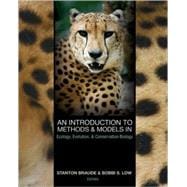
Note: Supplemental materials are not guaranteed with Rental or Used book purchases.
Purchase Benefits
Looking to rent a book? Rent An Introduction to Methods and Models in Ecology, Evolution, & Conservation Biology [ISBN: 9780691127248] for the semester, quarter, and short term or search our site for other textbooks by Braude, Stanton; Low, Bobbi S.. Renting a textbook can save you up to 90% from the cost of buying.
| Figures | p. vii |
| Tables | p. xi |
| Preface | p. xv |
| Acknowledgments | p. xvii |
| Introduction | p. xix |
| Evolutionary Biology | |
| Evolution and Pesticide Resistance: Examining Quantitative Trends Visually | p. 3 |
| Lizard Ecomorphology: Generating and Testing Hypotheses of Adaptation | p. 12 |
| Phyiogenetic Inference: Examining Morphological and Molecular Datasets | p. 22 |
| Life History Tradeoffs in Avian Clutch Size: Interpreting Life History Data and Evaluating Alternative Hypotheses | p. 36 |
| Mimicry: Experimental Design and Scientific Logic | p. 51 |
| Demography and Population Ecology | |
| Life Table Analysis | p. 63 |
| Lotka-Volterra Competition Modeling | p. 69 |
| Explosive Population Growth and Invasive Exotic Species | p. 79 |
| Island Biogeography: Evaluating Correlational Data and Testing Alternative Hypotheses | p. 91 |
| Population Genetics | |
| Hardy-Weinberg: Evaluating Disequilibrium Forces | p. 107 |
| Drift, Demographic Stochasticity, and Extinction in Woggles | p. 117 |
| Conservation of Small Populations: Effective Population Sizes, Inbreeding, and the 50/500 Rule | p. 125 |
| Dispersal and Metapopulation Structure | p. 139 |
| Quantitative Ecological Tools | |
| Understanding Descriptive Statistics | p. 155 |
| Understanding Statistical Inference | p. 179 |
| Sampling Wild Populations | p. 189 |
| Quantifying Biodiversity | p. 198 |
| Environmental Predictability and Life History | p. 214 |
| Modeling Optimal Foraging | p. 226 |
| Synthetic Exercises and Writing Assignments | |
| Evaluating Competing Hypotheses of Regional Biodiversity | p. 235 |
| Preparing and Evaluating Competitive Grant Proposals for Conservation Funding | p. 239 |
| Tracing the History of Scientific Ideas: From Darwin, Connell, or Soule to the Present | p. 245 |
| Glossary | p. 251 |
| Contributors | p. 263 |
| Index | p. 265 |
| Table of Contents provided by Ingram. All Rights Reserved. |
The New copy of this book will include any supplemental materials advertised. Please check the title of the book to determine if it should include any access cards, study guides, lab manuals, CDs, etc.
The Used, Rental and eBook copies of this book are not guaranteed to include any supplemental materials. Typically, only the book itself is included. This is true even if the title states it includes any access cards, study guides, lab manuals, CDs, etc.